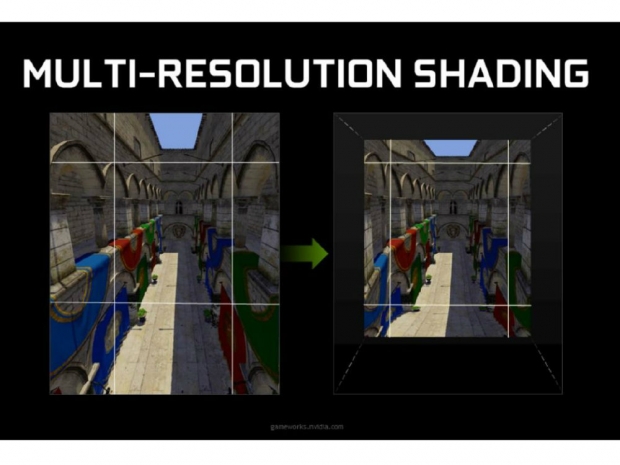Clever Nvidia software engineers have come up with an idea to use multi-resolution shading that can save you a lot of rendering power in VR. In virtual reality, the GPU is rendering a spherical 360-degree scene. What happens is that you see only a part of screen in your primary vision field. Nvidia has figured out that if you shave some pixels off from the peripheral parts of the scene, your eyes won't be able to tell the difference.
Nvidia uses 3x3 grid and uses multi-resolution shading to split the image up into multiple viewports. The center of the grid stays in the same resolution, but Nvidia degrades some pixels in other parts of the picture, with the final result being that you cannot tell that optimisation is taking place. With this technique Nvidia claims it can save 25% to 50% of the pixels. That translates into a 1.3x to 2x pixel shading speedup.
We saw a demo two weeks ago, and guess what, we could not tell the difference, even though Nvidia used this optimisation and shaved off anywhere between 20 and 50 percent of pixels in the scene.
Trust us, we really tried to notice the difference with 20 percent optimisation vs. without optimisation, but we could not. Nvidia's Matt Widener and Bryan Burk of Nvidia has pushed us even further and they turn the optimisation that was rendering 50 percent less pixels off and we could still not tell the difference.
As long as they would not touch the pixels in the main part of the screen, you would not be able to tell the difference. Matt is part of the magical place and the team that is lead under the supervision of Nick Stam and Sean Cleveland, and these guys are doing a lot of game testing, benchmarking and demo stuff.
The multi-resolution shading technology is very important, as virtual reality is very performance demanding and getting 25+ percent better performance is definitely something that is worthwhile. The crazy part is that despite the fact that Titan X has 8 billion transistors, Radeon Fury X aka Fiji XT has 8.6 billion transistors, it seems that we all need multiple times the performance of these latest and greatest chips.
So we cannot to 16nm and next generation 10nm or 7nm nodes soon enough, because we will need GPUs with tens of billions of transistors. In the meantime, graphics companies are going to use all possible tools and resources to get you the best experience. GameWorks VR multi rendering is one of them.




